Windsor Castle: Difference between revisions
No edit summary |
No edit summary |
||
| Line 20: | Line 20: | ||
|garrison= | |garrison= | ||
}} | }} | ||
'''Windsor Castle''' is The | '''Windsor Castle''' is The King's principal residence; a castle standing in the town of [[Windsor]] in [[Berkshire]], a town which owes its existence and prosperity to the castle. The castle is the largest in the [[British Isles]], and often held to be the largest inhabited castle in the world. It is famed for its long association with the British royal family and also for its architecture. | ||
The original castle was built in the 11th century after the Norman invasion by William the Conqueror. Since the time of Henry I, it has been used by succeeding monarchs and is the longest-occupied palace in Europe. The castle's lavish, early 19th-century State Apartments are architecturally significant, described by art historian Hugh Roberts as "a superb and unrivalled sequence of rooms widely regarded as the finest and most complete expression of later Georgian taste".<ref name="Hugh Roberts p.79">Hugh Roberts, ''Options Report for Windsor Castle'', cited Nicolson, p.79.</ref> The castle includes the 15th-century St George's Chapel, considered by historian John Martin Robinson to be "one of the supreme achievements of English Perpendicular Gothic" design.<ref name="Robinson, p.27">Robinson, p.27.</ref> More than five hundred people live and work in Windsor Castle. | The original castle was built in the 11th century after the Norman invasion by William the Conqueror. Since the time of Henry I, it has been used by succeeding monarchs and is the longest-occupied palace in Europe. The castle's lavish, early 19th-century State Apartments are architecturally significant, described by art historian Hugh Roberts as "a superb and unrivalled sequence of rooms widely regarded as the finest and most complete expression of later Georgian taste".<ref name="Hugh Roberts p.79">Hugh Roberts, ''Options Report for Windsor Castle'', cited Nicolson, p.79.</ref> The castle includes the 15th-century St George's Chapel, considered by historian John Martin Robinson to be "one of the supreme achievements of English Perpendicular Gothic" design.<ref name="Robinson, p.27">Robinson, p.27.</ref> More than five hundred people live and work in Windsor Castle. | ||
| Line 27: | Line 27: | ||
Originally designed to protect Norman dominance around the outskirts of London, and to oversee a strategically important part of the [[River Thames]], Windsor Castle was built as a motte and bailey, with three wards surrounding a central mound. Gradually replaced with stone fortifications, the castle withstood a prolonged siege during the First Barons' War at the start of the 13th century. Henry III built a luxurious royal palace within the castle during the middle of the century, and Edward III went further, rebuilding the palace to produce an even grander set of buildings in what would become "the most expensive secular building project of the entire Middle Ages in England".<ref name=BrindleKerrP39>Brindle and Kerr, p 39</ref> Edward's core design lasted through the Tudor period, during which Henry VIII and Elizabeth I made increasing use of the castle as a royal court and centre for diplomatic entertainment. | Originally designed to protect Norman dominance around the outskirts of London, and to oversee a strategically important part of the [[River Thames]], Windsor Castle was built as a motte and bailey, with three wards surrounding a central mound. Gradually replaced with stone fortifications, the castle withstood a prolonged siege during the First Barons' War at the start of the 13th century. Henry III built a luxurious royal palace within the castle during the middle of the century, and Edward III went further, rebuilding the palace to produce an even grander set of buildings in what would become "the most expensive secular building project of the entire Middle Ages in England".<ref name=BrindleKerrP39>Brindle and Kerr, p 39</ref> Edward's core design lasted through the Tudor period, during which Henry VIII and Elizabeth I made increasing use of the castle as a royal court and centre for diplomatic entertainment. | ||
Windsor Castle survived the tumultuous period of the Civil War, when it was used as a military headquarters for Parliamentary forces and a prison for Charles I. During the Restoration, Charles II rebuilt much of Windsor Castle with the help of architect Hugh May, creating a set of extravagant, Baroque interiors that are still admired. After a period of neglect during the 18th century, George III and George IV renovated and rebuilt Charles II's palace at colossal expense, producing the current design of the State Apartments, full of Rococo, Gothic and Baroque furnishings. Queen Victoria made minor changes to the castle, which became the centre for royal entertainment for much of her reign. Windsor Castle was used as a refuge for the royal family during the bombing campaigns of the Second World War and survived a fire in 1992. It is a popular tourist attraction, a venue for hosting state visits, and | Windsor Castle survived the tumultuous period of the Civil War, when it was used as a military headquarters for Parliamentary forces and a prison for Charles I. During the Restoration, Charles II rebuilt much of Windsor Castle with the help of architect Hugh May, creating a set of extravagant, Baroque interiors that are still admired. After a period of neglect during the 18th century, George III and George IV renovated and rebuilt Charles II's palace at colossal expense, producing the current design of the State Apartments, full of Rococo, Gothic and Baroque furnishings. Queen Victoria made minor changes to the castle, which became the centre for royal entertainment for much of her reign. Windsor Castle was used as a refuge for the royal family during the bombing campaigns of the Second World War and survived a fire in 1992. It is a popular tourist attraction, a venue for hosting state visits, and was Queen Elizabeth II's preferred weekend home. | ||
==Architecture== | ==Architecture== | ||
| Line 46: | Line 46: | ||
====State Apartments==== | ====State Apartments==== | ||
[[File:Windsor Castle Upper Ward Quadrangle 2 - Nov 2006.jpg|right|thumb|350px|The State Apartments in the Upper Ward; (l to r) the Official Entrance, St George's Hall; the Guest's Entrance]] | [[File:Windsor Castle Upper Ward Quadrangle 2 - Nov 2006.jpg|right|thumb|350px|The State Apartments in the Upper Ward; (l to r) the Official Entrance, St George's Hall; the Guest's Entrance]] | ||
The State Apartments form the major part of the Upper Ward and lie along the north side of the quadrangle. The modern building follows the mediæval foundations laid down by Edward III, with the ground floor comprising service chambers and cellars, and the much grander first floor forming the main part of the palace. On the first floor, the layout of the western end of the State Apartments is primarily the work of architect Hugh May, whereas the structure on the eastern side represents Jeffry Wyattville's plans.<ref group="nb">The | The State Apartments form the major part of the Upper Ward and lie along the north side of the quadrangle. The modern building follows the mediæval foundations laid down by Edward III, with the ground floor comprising service chambers and cellars, and the much grander first floor forming the main part of the palace. On the first floor, the layout of the western end of the State Apartments is primarily the work of architect Hugh May, whereas the structure on the eastern side represents Jeffry Wyattville's plans.<ref group="nb">The King's Drawing Room, King's Ballroom, King's Audience Chamber, King's Presence Chamber, King's Guard Chamber, King's Presence Chamber, King's Audience Room, King's Drawing Chamber and King's Dining Chamber residing in May's 17th-century structure; Wyattville transformed the layout of the eastern end of the State Apartments, forming the Grand Reception Room, White Drawing Room, Green Drawing Room, Crimson Drawing Room, the Waterloo Chamber, State Dining Room and Octagonal Dining Room.</ref> | ||
The interior of the State Apartments was mostly designed by Wyattville in the early 19th century. Wyattville intended each room to illustrate a particular architectural style and to display the matching furnishings and fine arts of the period.<ref>Nicolson, p.79.</ref> With some alterations over the years, this concept continues to dominate the apartments. Different rooms follow the Classical, Gothic and Rococo styles, together with an element of Jacobethan in places.<ref>Nicolson, pp.79, 172–3.</ref> Many of the rooms on the eastern end of the castle had to be restored following the 1992 fire, using "equivalent restoration" methods – the rooms were restored so as to appear similar to their original appearance, but using modern materials and concealing modern structural improvements. These rooms were also partially redesigned at the same time to more closely match modern tastes. Art historian Hugh Roberts has praised the State Apartments as "a superb and unrivalled sequence of rooms widely regarded as the finest and most complete expression of later Georgian taste."<ref name="Hugh Roberts p.79"/> Others, such as architect Robin Nicolson and critic Hugh Pearman, have described them as "bland" and "distinctly dull".<ref>Nicolson, p.70.</ref> | The interior of the State Apartments was mostly designed by Wyattville in the early 19th century. Wyattville intended each room to illustrate a particular architectural style and to display the matching furnishings and fine arts of the period.<ref>Nicolson, p.79.</ref> With some alterations over the years, this concept continues to dominate the apartments. Different rooms follow the Classical, Gothic and Rococo styles, together with an element of Jacobethan in places.<ref>Nicolson, pp.79, 172–3.</ref> Many of the rooms on the eastern end of the castle had to be restored following the 1992 fire, using "equivalent restoration" methods – the rooms were restored so as to appear similar to their original appearance, but using modern materials and concealing modern structural improvements. These rooms were also partially redesigned at the same time to more closely match modern tastes. Art historian Hugh Roberts has praised the State Apartments as "a superb and unrivalled sequence of rooms widely regarded as the finest and most complete expression of later Georgian taste."<ref name="Hugh Roberts p.79"/> Others, such as architect Robin Nicolson and critic Hugh Pearman, have described them as "bland" and "distinctly dull".<ref>Nicolson, p.70.</ref> | ||
| Line 53: | Line 53: | ||
Wyattville's most famous work are those rooms designed in a Rococo style. These rooms take the fluid, playful aspects of this mid-18th-century artistic movement, including many original pieces of Louis XV decoration, but project them on a "vastly inflated" scale.<ref>Ireland, p.93; Nicolson, p.191.</ref> Investigations after the 1992 fire have shown though that many Rococo features of the modern castle, originally thought to have been 18th-century fittings transferred from Carlton House or France, are in fact 19th-century imitations in plasterwork and wood, designed to blend with original elements.<ref>Nicolson, p.176.</ref> The Grand Reception Room is the most prominent of these Rococo designs, 100 ft (30 m) long and 40 ft (12 m) tall and occupying the site of Edward III's great hall.<ref>Nicolson, pp.123, 174; Brindle and Kerr, p.28.</ref> This room, restored after the fire, includes a huge French Rococo ceiling, characterised by Ian Constantinides, the lead restorer, as possessing a "coarseness of form and crudeness of hand ... completely overshadowed by the sheer spectacular effect when you are at a distance".<ref name=NicholsonP190>Nicolson, p.190.</ref> The room is set off by a set of restored Gobelins French tapestries.<ref name=NicholsonP190/> Although decorated with less gold leaf than in the 1820s, the result remains "one of the greatest set-pieces of Regency decoration".<ref>Brindle and Kerr, p.28; Nicolson, p.184.</ref> The White, Green and Crimson Drawing Rooms include a total of sixty-two trophies: carved, gilded wooden panels illustrating weapons and the spoils of war.<ref name=NicolsonPP197-8>Nicolson, pp.197–8.</ref> Restored or replaced after the fire, these trophies are famous for their "vitality, precision and three-dimensional quality", and were originally brought from Carlton House in 1826, some being originally imported from France and others carved by Edward Wyatt.<ref name=NicolsonPP197-8/> The soft furnishings of these rooms, although luxurious, are more modest than the 1820s originals, both on the grounds of modern taste and cost.<ref>Nicolson, pp.206–7.</ref> | Wyattville's most famous work are those rooms designed in a Rococo style. These rooms take the fluid, playful aspects of this mid-18th-century artistic movement, including many original pieces of Louis XV decoration, but project them on a "vastly inflated" scale.<ref>Ireland, p.93; Nicolson, p.191.</ref> Investigations after the 1992 fire have shown though that many Rococo features of the modern castle, originally thought to have been 18th-century fittings transferred from Carlton House or France, are in fact 19th-century imitations in plasterwork and wood, designed to blend with original elements.<ref>Nicolson, p.176.</ref> The Grand Reception Room is the most prominent of these Rococo designs, 100 ft (30 m) long and 40 ft (12 m) tall and occupying the site of Edward III's great hall.<ref>Nicolson, pp.123, 174; Brindle and Kerr, p.28.</ref> This room, restored after the fire, includes a huge French Rococo ceiling, characterised by Ian Constantinides, the lead restorer, as possessing a "coarseness of form and crudeness of hand ... completely overshadowed by the sheer spectacular effect when you are at a distance".<ref name=NicholsonP190>Nicolson, p.190.</ref> The room is set off by a set of restored Gobelins French tapestries.<ref name=NicholsonP190/> Although decorated with less gold leaf than in the 1820s, the result remains "one of the greatest set-pieces of Regency decoration".<ref>Brindle and Kerr, p.28; Nicolson, p.184.</ref> The White, Green and Crimson Drawing Rooms include a total of sixty-two trophies: carved, gilded wooden panels illustrating weapons and the spoils of war.<ref name=NicolsonPP197-8>Nicolson, pp.197–8.</ref> Restored or replaced after the fire, these trophies are famous for their "vitality, precision and three-dimensional quality", and were originally brought from Carlton House in 1826, some being originally imported from France and others carved by Edward Wyatt.<ref name=NicolsonPP197-8/> The soft furnishings of these rooms, although luxurious, are more modest than the 1820s originals, both on the grounds of modern taste and cost.<ref>Nicolson, pp.206–7.</ref> | ||
Wyattville's design retains three rooms originally built by Hugh May in the 17th century in partnership with the painter Antonio Verrio and carver Grinling Gibbons. The | Wyattville's design retains three rooms originally built by Hugh May in the 17th century in partnership with the painter Antonio Verrio and carver Grinling Gibbons. The King's Presence Chamber, the King's Audience Chamber and the King's Dining Room are designed in a Baroque, Franco-Italian style, characterised by "gilded interiors enriched with florid murals", first introduced to England between 1648–50 at Wilton House.<ref>Watkin, p.345.</ref> Verrio's paintings are "drenched in mediævalist allusion" and classical images.<ref>Nicolson, p.128.</ref> These rooms were intended to show an innovative English "baroque fusion" of the hitherto separate arts of architecture, painting and carving.<ref>Rowse, p.95.</ref> | ||
[[File:Windsor Castle Private Chapel.jpg|right|thumb|200px|Presentation drawing for the new Private Chapel]] | [[File:Windsor Castle Private Chapel.jpg|right|thumb|200px|Presentation drawing for the new Private Chapel]] | ||
| Line 181: | Line 181: | ||
After the war the king revived the "dine and sleep" events at Windsor, following comments that the castle had become "almost like a vast, empty museum"; nonetheless, it took many years to restore Windsor Castle to its pre-war condition.<ref>Shawcross, pp.604–5; p.594.</ref> | After the war the king revived the "dine and sleep" events at Windsor, following comments that the castle had become "almost like a vast, empty museum"; nonetheless, it took many years to restore Windsor Castle to its pre-war condition.<ref>Shawcross, pp.604–5; p.594.</ref> | ||
In February 1952, Elizabeth II came to the throne and decided to make Windsor her principal weekend retreat.<ref name=Mackworth-YoungP88>Mackworth-Young, p.88.</ref> The private apartments were renovated and further modernised, and the Queen, Prince Philip and their children took up residence.<ref name=Mackworth-YoungP88/> A programme of repair work to replace the heating and the wiring of the Upper Ward began in 1988<ref>Nicolson, p.4.</ref> and work was undertaken to underpin the motte of the Round Tower after fresh subsidence was detected in 1988, threatening the collapse of the tower.<ref>Emery, p.193; Brindle and Kerr, p.5.</ref> | In February 1952, Elizabeth II came to the throne and decided to make Windsor her principal weekend retreat.<ref name=Mackworth-YoungP88>Mackworth-Young, p.88.</ref> The private apartments were renovated and further modernised, and the late Queen, Prince Philip and their children took up residence.<ref name=Mackworth-YoungP88/> A programme of repair work to replace the heating and the wiring of the Upper Ward began in 1988<ref>Nicolson, p.4.</ref> and work was undertaken to underpin the motte of the Round Tower after fresh subsidence was detected in 1988, threatening the collapse of the tower.<ref>Emery, p.193; Brindle and Kerr, p.5.</ref> | ||
[[File:Carved unicorn212334.jpg|left|thumb|200px|One of four Queen's Beasts replacing those destroyed in the 1992 fire]] | [[File:Carved unicorn212334.jpg|left|thumb|200px|One of four Queen's Beasts replacing those destroyed in the 1992 fire]] | ||
Latest revision as of 08:51, 20 November 2023
| Windsor Castle | |
|
Berkshire | |
|---|---|
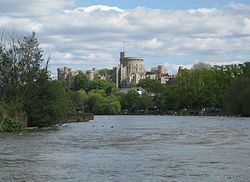 Windsor Castle and the Thames | |
| Type: | Three bailey wards with a central keep |
| Location | |
| Grid reference: | SU97027700 |
| Location: | 51°29’1"N, -0°36’15"W |
| Town: | Windsor |
| History | |
| Built 11th – 19th centuries | |
| Key events: | First Barons' War, Civil War |
| Information | |
| Condition: | Intact |
| Owned by: | The King |
Windsor Castle is The King's principal residence; a castle standing in the town of Windsor in Berkshire, a town which owes its existence and prosperity to the castle. The castle is the largest in the British Isles, and often held to be the largest inhabited castle in the world. It is famed for its long association with the British royal family and also for its architecture.
The original castle was built in the 11th century after the Norman invasion by William the Conqueror. Since the time of Henry I, it has been used by succeeding monarchs and is the longest-occupied palace in Europe. The castle's lavish, early 19th-century State Apartments are architecturally significant, described by art historian Hugh Roberts as "a superb and unrivalled sequence of rooms widely regarded as the finest and most complete expression of later Georgian taste".[1] The castle includes the 15th-century St George's Chapel, considered by historian John Martin Robinson to be "one of the supreme achievements of English Perpendicular Gothic" design.[2] More than five hundred people live and work in Windsor Castle.
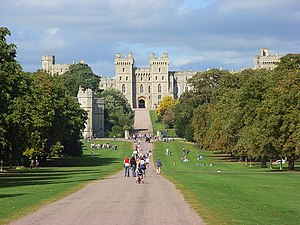
Originally designed to protect Norman dominance around the outskirts of London, and to oversee a strategically important part of the River Thames, Windsor Castle was built as a motte and bailey, with three wards surrounding a central mound. Gradually replaced with stone fortifications, the castle withstood a prolonged siege during the First Barons' War at the start of the 13th century. Henry III built a luxurious royal palace within the castle during the middle of the century, and Edward III went further, rebuilding the palace to produce an even grander set of buildings in what would become "the most expensive secular building project of the entire Middle Ages in England".[3] Edward's core design lasted through the Tudor period, during which Henry VIII and Elizabeth I made increasing use of the castle as a royal court and centre for diplomatic entertainment.
Windsor Castle survived the tumultuous period of the Civil War, when it was used as a military headquarters for Parliamentary forces and a prison for Charles I. During the Restoration, Charles II rebuilt much of Windsor Castle with the help of architect Hugh May, creating a set of extravagant, Baroque interiors that are still admired. After a period of neglect during the 18th century, George III and George IV renovated and rebuilt Charles II's palace at colossal expense, producing the current design of the State Apartments, full of Rococo, Gothic and Baroque furnishings. Queen Victoria made minor changes to the castle, which became the centre for royal entertainment for much of her reign. Windsor Castle was used as a refuge for the royal family during the bombing campaigns of the Second World War and survived a fire in 1992. It is a popular tourist attraction, a venue for hosting state visits, and was Queen Elizabeth II's preferred weekend home.
Architecture
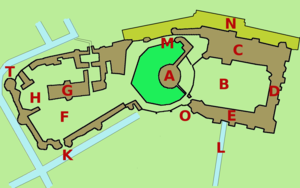
Windsor Castle occupies a large site of more than thirteen acres and combines the features of a fortification, a palace, and a small town.[4] The present-day castle was created during a sequence of phased building projects, culminating in the reconstruction work after a fire in 1992.[5] It is in essence a Georgian and Victorian design based on a mediæval structure, with Gothic features reinvented in a modern style. Since the 14th century, architecture at the castle has attempted to produce a contemporary reinterpretation of older fashions and traditions, repeatedly imitating outmoded or even antiquated styles.[6] As a result, architect Sir William Whitfield has pointed to Windsor Castle's architecture as having "a certain fictive quality", the Picturesque and Gothic design generating "a sense that a theatrical performance is being put on here", despite late 20th century efforts to expose more of the older structures to increase the sense of authenticity.[7] Although there has been some criticism, the castle's architecture and history lends it a "place amongst the greatest European palaces".[8]
Middle Ward
At the heart of Windsor Castle, the Middle Ward is a bailey around the 50-foot height chalk-built motte in the centre of the ward, on which stands the keep, called the Round Tower. The Round Tower is based on an original 12th-century building, extended upwards by 30 feet in the early 19th century under architect Jeffry Wyattville, to produce a more imposing height and silhouette.[9] The interior of the Round Tower was further redesigned in 1991–3 to provide additional space for the Royal Archives, an additional room being built in the space left by Wyattville's originally hollow extension.
The western entrance to the Middle Ward is now open, and a gateway leads north from the ward onto the North Terrace.[10] The eastern exit from the ward is guarded by the Norman Gatehouse,[10] actually of the 14th century, heavily vaulted and decorated with carvings, including surviving mediæval lion masks, traditional symbols of majesty, to form an impressive entrance to the Upper Ward.[11]
Upper Ward
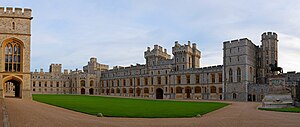
The Upper Ward of Windsor Castle contains several major buildings, enclosed by the upper bailey wall, forming a central quadrangle. The State Apartments run along the north of the ward, with a range of buildings along the east wall, and the private royal apartments and the King George IV Gate to the south, with the Edward III Tower in the south-west corner. The motte and the Round Tower form the west edge of the ward. A bronze statue of Charles II on horseback sits beneath the Round Tower.[12] Inspired by Hubert Le Sueur's statue of Charles I in London, the statue was cast by Josias Ibach in 1679, with the marble plinth featuring carvings by Grinling Gibbons.[12] The Upper Ward adjoins the North Terrace, which overlooks the River Thames, and the East Terrace, which overlooks the gardens; both of the current terraces were constructed by Hugh May in the 17th century.[13]
The Upper Ward has been adjudged "to all intents and purposes a nineteenth-century creation ... the image of what the early nineteenth-century thought a castle should be", as a result of the extensive redesign of the castle by Wyattville under George IV.[14] The buildings in the Upper Ward are characterised by the use of small bits of flint in the mortar for galletting, originally started at the castle in the 17th century to give stonework from disparate periods a similar appearance. The skyline of the Upper Ward is designed to be dramatic when seen from a distance or silhouetted against the horizon, an image of tall towers and battlements influenced by the picturesque movement of the late 18th century.[15] The current structure represents a survival of elements from the original 12th-century stone walls onwards.[16]
State Apartments
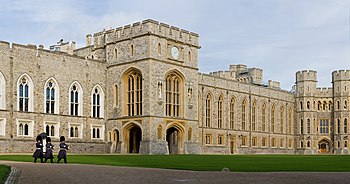
The State Apartments form the major part of the Upper Ward and lie along the north side of the quadrangle. The modern building follows the mediæval foundations laid down by Edward III, with the ground floor comprising service chambers and cellars, and the much grander first floor forming the main part of the palace. On the first floor, the layout of the western end of the State Apartments is primarily the work of architect Hugh May, whereas the structure on the eastern side represents Jeffry Wyattville's plans.[nb 1]
The interior of the State Apartments was mostly designed by Wyattville in the early 19th century. Wyattville intended each room to illustrate a particular architectural style and to display the matching furnishings and fine arts of the period.[17] With some alterations over the years, this concept continues to dominate the apartments. Different rooms follow the Classical, Gothic and Rococo styles, together with an element of Jacobethan in places.[18] Many of the rooms on the eastern end of the castle had to be restored following the 1992 fire, using "equivalent restoration" methods – the rooms were restored so as to appear similar to their original appearance, but using modern materials and concealing modern structural improvements. These rooms were also partially redesigned at the same time to more closely match modern tastes. Art historian Hugh Roberts has praised the State Apartments as "a superb and unrivalled sequence of rooms widely regarded as the finest and most complete expression of later Georgian taste."[1] Others, such as architect Robin Nicolson and critic Hugh Pearman, have described them as "bland" and "distinctly dull".[19]
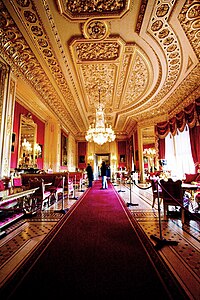
Wyattville's most famous work are those rooms designed in a Rococo style. These rooms take the fluid, playful aspects of this mid-18th-century artistic movement, including many original pieces of Louis XV decoration, but project them on a "vastly inflated" scale.[20] Investigations after the 1992 fire have shown though that many Rococo features of the modern castle, originally thought to have been 18th-century fittings transferred from Carlton House or France, are in fact 19th-century imitations in plasterwork and wood, designed to blend with original elements.[21] The Grand Reception Room is the most prominent of these Rococo designs, 100 ft (30 m) long and 40 ft (12 m) tall and occupying the site of Edward III's great hall.[22] This room, restored after the fire, includes a huge French Rococo ceiling, characterised by Ian Constantinides, the lead restorer, as possessing a "coarseness of form and crudeness of hand ... completely overshadowed by the sheer spectacular effect when you are at a distance".[23] The room is set off by a set of restored Gobelins French tapestries.[23] Although decorated with less gold leaf than in the 1820s, the result remains "one of the greatest set-pieces of Regency decoration".[24] The White, Green and Crimson Drawing Rooms include a total of sixty-two trophies: carved, gilded wooden panels illustrating weapons and the spoils of war.[25] Restored or replaced after the fire, these trophies are famous for their "vitality, precision and three-dimensional quality", and were originally brought from Carlton House in 1826, some being originally imported from France and others carved by Edward Wyatt.[25] The soft furnishings of these rooms, although luxurious, are more modest than the 1820s originals, both on the grounds of modern taste and cost.[26]
Wyattville's design retains three rooms originally built by Hugh May in the 17th century in partnership with the painter Antonio Verrio and carver Grinling Gibbons. The King's Presence Chamber, the King's Audience Chamber and the King's Dining Room are designed in a Baroque, Franco-Italian style, characterised by "gilded interiors enriched with florid murals", first introduced to England between 1648–50 at Wilton House.[27] Verrio's paintings are "drenched in mediævalist allusion" and classical images.[28] These rooms were intended to show an innovative English "baroque fusion" of the hitherto separate arts of architecture, painting and carving.[29]
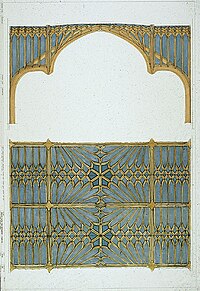
A handful of rooms in the modern State Apartments reflect either 18th-century or Victorian Gothic design. The State Dining Room, for example, whose current design originates from the 1850s but which was badly damaged during the 1992 fire, is restored to its appearance in the 1920s, before the removal of some of the gilded features on the pilasters.[30] Anthony Salvin's Grand Staircase is also of mid-Victorian design in the Gothic style, rising to a double-height hall lit by an older 18th-century Gothic vaulted lantern tower called the Grand Vestibule, designed by James Wyatt and executed by Francis Bernasconi.[31] The staircase has been criticised by historian John Robinson as being a distinctly inferior design to the earlier staircases built on the same site by both Wyatt and May.[32]
Some parts of the State Apartments were completely destroyed in the 1992 fire and this area was rebuilt in a style called "Downesian Gothic", named after the architect, Giles Downes.[33][nb 2] The style comprises "the rather stripped, cool and systematic coherence of modernism sewn into a reinterpretation of the Gothic tradition".[34] Downes argues that the style avoids "florid decoration", emphasising an organic, flowing Gothic structure.[35] Three new rooms were built or remodelled by Downes at Windsor. Downes' new roof of St George's Hall is the largest green-oak structure built since the Middle Ages, and is decorated with brightly coloured shields celebrating the heraldic element of the Order of the Garter; the design attempts to create an illusion of additional height through the gothic woodwork along the ceiling.[36] The Lantern Lobby features flowing oak columns forming a vaulted ceiling, imitating an arum lily.[37] The new Private Chapel is relatively small, only able to fit thirty worshippers, but combines architectural elements of the St George's Hall roof with the Lantern Lobby and the stepped arch structure of the Henry VIII chapel vaulting at Hampton Court.[38] The result is an "extraordinary, continuous and closely moulded net of tracery", complementing the new stained glass windows commemorating the fire, designed by Joseph Nuttgen.[39] The Great Kitchen, with its newly exposed 14th-century roof lantern sitting alongside Wyattville's fireplaces, chimneys and Gothic tables, is also a product of the reconstruction after the fire.[40]
The ground floor of the State Apartments retains various famous mediæval features. The 14th-century Great Undercroft still survives, some 193 ft long by 31 ft wide, divided into thirteen bays.[41] At the time of the 1992 fire, the Undercroft had been divided into smaller rooms; the area is now opened up to form a single space in an effort to echo the undercrofts at Fountains and Rievaulx Abbeys, although the floor remains artificially raised for convenience of use.[42] The "beautifully vaulted" 14th-century Larderie passage runs alongside the Kitchen Courtyard and is decorated with carved royal roses, marking its construction by Edward III.[43][nb 3]
Lower Ward
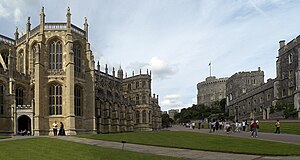
The Lower Ward lies below and to the west of the Round Tower, through the Norman Gate. The mediæval design was much renovated during the mid-Victorian period to form a "consistently Gothic composition".[44] The Lower Ward holds St George's Chapel and most of the buildings associated with the Order of the Garter.
St George's Chapel is a huge 15th-16th century building, the spiritual home of the Order of the Knights of the Garter, designed in the Perpendicular Gothic style.[45] The ornate wooden choir stalls are of 15th-century design, having been restored and extended by Henry Emlyn at the end of the 18th century, and are decorated with a unique set of brass plates showing the arms of the Knights of the Garter over the last six centuries.[46] The east stained glass window is Victorian, and the oriel window to the north side of it was built by Henry VIII for Catherine of Aragon.[47] The vault in front of the altar houses the remains of Henry VIII, Jane Seymour and Charles I, with Edward IV buried nearby.[48] The chapel is considered by historian John Robinson to be "one of the supreme achievements of English Perpendicular Gothic" design.[2]
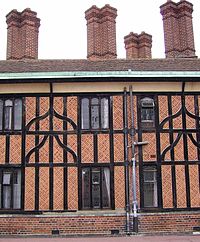
The Albert Memorial Chapel was converted from Henry III's Lady Chapel to commemorate the life of Prince Albert. The ornate east door remains from 1246.[49]
The Horseshoe Cloister was built in 1480 to house the chapel clergy, as it still does. This curved brick and timber building is said to have been designed to resemble the shape of a fetlock, one of the badges used by Edward IV. George Gilbert Scott heavily restored the building in 1871 and little of the original structure remains.[50] Ranges built by Edward III alongside the Horseshoe are used as offices, a library and as the houses for the Dean and Canons.[50]
The Curfew Tower, one of the oldest surviving parts of the Lower Ward is of the 13th century.[51] The interior of the tower contains a former dungeon, and the remnants of a sally port, a secret exit for the occupants in a time of siege.[52] The upper storey contains the castle bells placed there in 1478, and the castle clock of 1689. The French-style conical roof is a 19th-century attempt by Anthony Salvin to remodel the tower in the fashion of Eugène Viollet-le-Duc's recreation of Carcassonne.[53]
Here also is a range of buildings including the lodgings of the Military Knights, and the residence of the Governor of the Military Knights.[54]
Park and landscape
Windsor Castle's position on top of steep ground has meant that the castle's gardens are limited in scale.[55] The castle gardens stretch east from the Upper Ward across a 20th-century terrace.[56] Windsor Castle is surrounded by extensive parkland. The immediate area stretching to the east of the castle is a 19th-century creation known as the Home Park.[57] The Home Park includes parkland and two working farms, along with many estate cottages mainly occupied by employees and the Frogmore estate. The Long Walk, a double lined avenue of trees, runs for 3 miles south of the castle, and is 240 feet wide.[58] The original 17th-century elms were replaced with alternating chestnut and plane trees. The impact of Dutch elm disease led to large-scale replanting after 1945.[59]
The Home Park adjoins the northern edge of the more extensive Windsor Great Park, occupying some 4,800 acres and including some of the oldest broadleaved woodlands in Europe.[60] In the Home Park, to the north of the castle, stands a private school, St George's, which provides choristers to the chapel. Eton College is located within about half a mile of the castle, across the River Thames in Buckinghamshire.
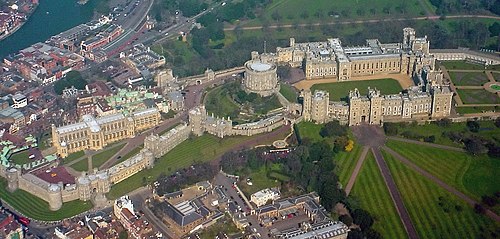
History
11th and 12th century
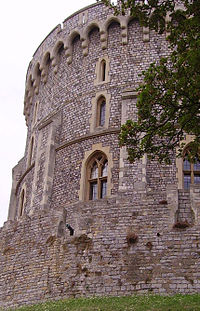
The first Windsor Castle was built by William the Conqueror in the decade after the Norman conquest of 1066,[61] as one of a defensive ring of motte and bailey castles around London, each a day's march (about 20 miles) from the city and from the next castle, allowing for easy reinforcements in a crisis.[61] Windsor Castle guarded the River Thames and was by Windsor Forest, a royal hunting preserve. The nearby settlement of ‘’Clivore’’, or Clewer, was an old royal residence. The initial wooden castle consisted of a keep on the top of a man-made motte, or mound, protected by a small bailey wall, occupying a chalk inlier, or bluff, rising 100 feet above the river.[62] A second wooden bailey to the east of the keep formed the later Upper Ward,[63] and by the end of the century, another bailey had been built to the west, creating the basic shape of the modern castle.
Edward the Confessor's had a residence in Windsor, which is now the village of Old Windsor, and the first two Norman kings continued it.[64] Henry I was the first to reside in the castle. His marriage to Adela, the daughter of Godfrey of Louvain, took place in the castle in 1121. During this period the keep suffered a substantial collapse apparently when the motte subsided by over 6 feet.[65] Timber piles were driven in to support the motte and the old wooden keep was replaced with a new stone shell keep, with a probable gateway to the north-east and a new stone well.[66] A chemise, or low protective wall, was subsequently added to the keep.[66]
Henry II built extensively at Windsor between 1165 and 1179, as to the motte, the tower and the walls, and he remodelled the royal accommodation.[63]
13th century
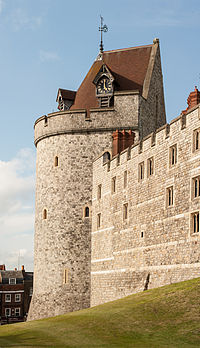
King John's main work was to the accommodation. Then came the revolt of the barons. The castle was besieged in 1214, and the King used the castle as his base during the negotiations before the signing of the Magna Carta at nearby Runnymede in 1215.[67] In 1216 the castle was besieged again by baronial and French troops but John's constable, Engelard de Cigogné, successfully defended it.[67]
Henry III repaired the damage and further strengthened the defences.[68] The walls of the Lower Ward were rebuilt in stone. Three new towers, the Curfew, Garter and the Salisbury towers, were built.[67] The Middle Ward was heavily reinforced with a southern stone wall. Henry also spent heavily on the royal accommodation; more than in any other of his properties, and created a division between a more private Upper Ward and a Lower Ward devoted to the public face of the monarchy.[49]
14th century
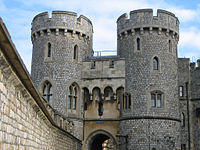
Edward III was born at Windsor Castle and used it extensively throughout his reign.[69] He founded the Order of the Garter here, and decided to rebuild Windsor Castle, in particular Henry III's palace, in an attempt to construct a castle that would be symbolic of royal power and chivalry.[70] Between 1350 and 1377 King Edward spent £51,000 on renovating Windsor Castle; this was the largest amount spent by any English mediæval monarch on a single building operation, and over one and a half times Edward's typical annual income of £30,000.[71] Some of the costs of the castle were paid from the results of ransoms following Edward's victories at the battles of Crécy, Calais and Poitiers.[69] Windsor Castle was already a substantial building before Edward began expanding it and lavished it with rich furnishings.[72] The castle was "the most expensive secular building project of the entire Middle Ages in England".[3]

Edward built further luxurious, self-contained lodgings for his court around the east and south edges of the Upper Ward, creating the modern shape of the quadrangle.[6] The Norman gate was built to secure the west entrance to the Ward.[69] In the Lower Ward, the chapel was enlarged and remodelled with grand buildings for the canons built alongside.[69] The earliest weight-driven mechanical clock in England was installed by Edward III in the Round Tower in 1354.[73] William of Wykeham went on to build New College, Oxford and Winchester College, where the influence of Windsor Castle can easily be seen.[69]
The new castle was used to hold French prisoners taken in at Poitiers in 1357, including the French king, John II, who was for a considerable ransom.[74]
Later in the century, King Richard II conducted restoration work on St George's Chapel, the work being carried out by Geoffrey Chaucer as Clerk of The King's Works.
15th century
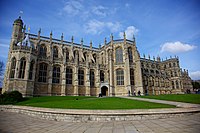
In 1399, Henry Bolinbroke seized the castle in his way to seizing the throne, but failed to catch Richard II, who had escaped to London.[75] Under Henry V, the castle hosted a visit from Sigismund, the Holy Roman Emperor, in 1417, a major diplomatic event that stretched the accommodation of the castle to its limits.[76]
Edward of York (Edward IV) seized the throne in 1461 and there consigned Margaret of Anjou, Henry VI's queen.[77] Edward began to revive the Order of the Garter, and held a particularly lavish feast in 1472,[78] and began the construction of the present St George's Chapel.
Henry VII in 1488, shortly after achieving the throne, held a massive feast for the Order of the Garter at the castle.[79] Henry remodelled the King's Chamber, had the roof of the Great Kitchen rebuilt and also built a three-storied tower on the west end of the palace, which he used for his personal apartments.[80] Windsor began to be used for international diplomatic events, including the grand visit of Philip I of Castile in 1506.[79]
16th century
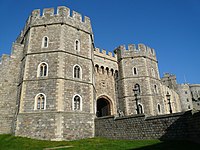
Henry VIII enjoyed Windsor Castle, as a young man "exercising himself daily in shooting, singing, dancing, wrestling, casting of the bar, playing at the recorders, flute, virginals, in setting of songs and making of ballads".[81] The tradition of the Garter Feasts was maintained and became more extravagant; the size of the royal retinue visiting Windsor had to be restricted because of the growing numbers.[82] During the Pilgrimage of Grace, a huge uprising in the north of England against Henry's rule in 1536, the king used Windsor as a secure base in the south from which to manage his military response.[83] Throughout the Tudor period, Windsor was also used as a safe retreat in the event of plagues occurring in London.[84]
Henry rebuilt the principal castle gateway in about 1510 and constructed a tennis court at the base of the motte in the Upper Ward.[85] He also built a long terrace, called the North Wharf, along the outside wall of the Upper Ward; constructed of wood, it was designed to provide a commanding view of the River Thames below.[86] The design included an outside staircase into the king's apartments, which made the monarch's life more comfortable at the expense of considerably weakening the castle's defences.[87]
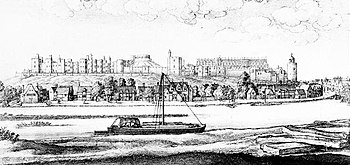
The young King Edward VI, austere and Protestant, disliked Windsor Castle.[88] He discontinued the annual Feast of the Garter at Windsor and removed any signs of popish practices with the Order.[89] Edward famously commented whilst staying at Windsor Castle for safety during trouble that "Methink I am in a prison, here are no galleries, nor no gardens to walk in".[88] Under both Edward and his sister, Bloody Mary, some limited building work continued at the castle. Water was piped into the Upper Ward to create a fountain.[86] Mary also expanded the buildings used by the Knights of Windsor in the Lower Ward, using stone from Reading Abbey.[86]
Elizabeth I spent much of her time at Windsor Castle and used it a safe haven in crises, "knowing it could stand a siege if need be".[90] Ten new brass cannons were purchased for the castle's defence.[91] It became one of her favourite locations and she spent more money on the property than on any of her other palaces.[92] She conducted some modest building works at Windsor, including a wide range of repairs to the existing structures.[93] She converted the North Wharf into a permanent, huge stone terrace, complete with statues, carvings and an octagonal, outdoor banqueting house, raising the western end of the terrace to provide more privacy.[94] The chapel was refitted with stalls, a gallery and a new ceiling.[95] A bridge was built over the ditch to the south of the castle to enable easier access to the park.[92] Elizabeth built a gallery range of buildings on the west end of the Upper Ward, alongside Henry VII's tower.[96] Elizabeth used the castle for diplomatic engagements, but it lacked the space of the more modern royal palaces.[97] This flow of foreign visitors was captured for the queen's entertainment in William Shakespeare's play, The Merry Wives of Windsor.[98]
17th century
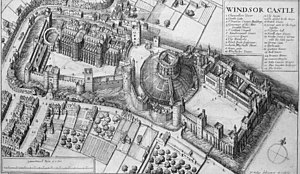
For James I, Windsor was a base for hunting and for socialising:[99] one session with Christian IV of Denmark in 1606 that became infamous across Europe for the resulting drunken behaviour of the two kings.[100]
Charles I was a connoisseur of art and had the castle completely surveyed by a team including Inigo Jones in 1629, but little was carried out[95] beyond Nicholas Stone's improvements to the chapel gallery in the Mannerist style and a gateway in the North Terrace.[95] Christian van Vianen, a noted Dutch goldsmith, was employed to produce a baroque gold service for the communion table in St George's Chapel. In the final years of peace, Charles demolished the fountain in the Upper Ward, intending to replace it with a classical statue.[101]
During the Civil War, John Venn took control of Windsor Castle on behalf of Parliament with twelve companies of foot soldiers to protect the route along the Thames in case the King were to advance on London. The contents of St George's Chapel were both valuable and overly popish in style and so were grievously looted: Edward IV's bejewelled coat of mail was stolen; the chapel's organs, windows and books destroyed; the Lady Chapel was emptied of valuables, including the component parts of Henry VIII's unfinished tomb.[102] By the end of the war, some 3,580 oz of gold and silver plate had been looted.[103]
Prince Rupert of the Rhine, a prominent Royalist general, attempted to relieve Windsor Castle that November.[103] Rupert's small force of cavalry was able to take the town of Windsor, but was unable to overcome the walls at Windsor Castle – in due course, Rupert was forced to retreat.[104] Over the winter of 1642–3, Windsor Castle was converted into the headquarters for the Earl of Essex, a senior Parliamentary general.[104] The Horseshoe Cloister was taken over as a prison for captured Royalists, and the resident canons were expelled from the castle.[104] The Lady Chapel was turned into a magazine.[105] Looting by the underpaid garrison continued to be a problem; 500 royal deer were killed across the Windsor Great Park during the winter, and fences were burned as firewood.[104]
In 1647 Charles, then a prisoner of Parliament, was brought to the castle for a period under arrest, before being moved to Hampton Court.[104] In 1648 there was a Royalist plan, never enacted, to seize Windsor Castle.[106] The Parliamentary Army Council moved into Windsor in November and decided to try Charles for treason.[106] Charles was held at Windsor again for the last three weeks of his reign; after his execution in January 1649, his body was taken back to Windsor that night through a snowstorm, to be interred without ceremony in the vault beneath St George's Chapel.[107]
At the Restoration in 1660 it was found that the "King's house was a wreck; the fanatic, the pilferer, and the squatter, having been at work ... Paupers had squatted in many of the towers and cabinets".[108] Shortly after returning to England, Charles appointed Prince Rupert, one of his few surviving close relatives, to be the Constable of Windsor Castle in 1668.[109] Rupert immediately began to reorder the castle's defences, repairing the Round Tower and reconstructing the real tennis court.[110] Charles attempted to restock Windsor Great Park with deer brought over from Germany, but the herds never recovered their pre-war size.[104] Rupert created apartments for himself in the Round Tower, decorated with an "extraordinary" number of weapons and armour, with his inner chambers "hung with tapisserie, curious and effeminate pictures".[111]
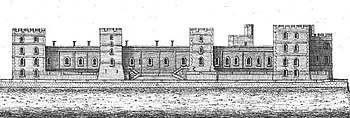
Charles was heavily influenced by the works of Louis XIV of France, imitating French design at his palace at Winchester and the Royal Hospital at Chelsea.[112] At Windsor, Charles created "the most extravagantly Baroque interiors ever executed in England".[112] Much of the building work was paid for out of increased royal revenues from Ireland during the 1670s.[113] After a great deal of work, Windsor Castle was big enough to hold the entire court, but it was not built with chambers for the King's Council, as would be found in Whitehall[114] and instead Charles held his council meetings at Hampton Court when he was staying at the castle.[114] The result became an "exemplar" for royal buildings for the next twenty-five years.[115]
William III commissioned Nicholas Hawksmoor and Sir Christopher Wren to conduct a large, final classical remodelling of the Upper Ward, but the king's early death caused the plan to be cancelled.[116] Queen Anne was fond of the castle, and attempted to address the lack of a formal garden by instructing Henry Wise to begin work on the Maestricht Garden beneath the North Terrace, which was never completed.[116] Anne also created the racecourse at Ascot and began the tradition of the annual Royal Ascot procession from the castle.[117]
18th century
George I took little interest in Windsor Castle, preferring his other palaces at St James's, Hampton Court and Kensington.[118] George II rarely used Windsor either, preferring Hampton Court.[119] Many of the apartments in the Upper Ward were given out as "grace and favour" privileges for the use of prominent widows or other friends of the Crown.[120] Duke of Cumberland made the most use of the property in his role as the Ranger of Windsor Great Park.[121] By the 1740s, Windsor Castle had become an early tourist attraction; wealthier visitors who could afford to pay the castle keeper could enter, see curiosities such as the castle's narwhal horn, and by the 1750s buy the first guidebooks to Windsor, produced by George Bickham in 1753 and Joseph Pote in 1755.[122] As the condition of the State Apartments continued to deteriorate, even the general public were able to regularly visit the property.[123]
George III reversed this trend when he came to the throne in 1760.[120] George disliked Hampton Court, and was attracted by the park at Windsor Castle.[120] George wanted to move into the Ranger's House by the castle, but his brother, Henry was already living in it and refused to move out.[124] Instead, George had to move into the Upper Lodge, later called the Queen's Lodge, and started the long process of renovating the castle and the surrounding parks.[124] Initially the atmosphere at the castle remained very informal, with local children playing games inside the Upper and Lower Wards, and the royal family frequently seen as they walked around the grounds.[123] As time went by, however, access for visitors became more limited.[118]
Working with the architect James Wyatt, George attempted to "transform the exterior of the buildings in the Upper Ward into a Gothic palace, while retaining the character of the Hugh May state rooms".[125] The outside of the building was restyled with Gothic features, including new battlements and turrets.[125] Inside, conservation work was undertaken, and several new rooms constructed, including a new Gothic staircase to replace May's 17th-century version, complete with the Grand Vestibule ceiling above it.[126] New paintings were purchased for the castle, and collections from other royal palaces moved there by the king.[127] The cost of the work came to over £150,000 (£100 million in 2008 terms).[128] The king undertook extensive work in the castle's Great Park as well, laying out the new Norfolk and Flemish farms, creating two dairies and restoring the Virginia Water lake, grotto and follies.[129]
In 1788 the king first became ill during a dinner at Windsor Castle; diagnosed as suffering from madness, he was removed for a period to Kew, where he temporarily recovered.[130] After relapses in 1801 and 1804, his condition became enduring from 1810 onwards and he was confined in the State Apartments of Windsor Castle, with building work on the castle ceasing the following year.[131]
19th century
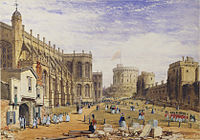
George IV came to the throne in 1820 intending to create a set of royal palaces that reflected his wealth and influence as the ruler of an increasingly powerful Britain.[132] George's previous houses, Carlton House and the Brighton Pavilion were too small for grand court events, even after expensive extensions.[132] George expanded the Royal Lodge in the castle park whilst he was Prince Regent, and then began a programme of work to modernise the castle itself once he became king.[132]
Work commenced on Windsor in 1824 under Jeffry Wyattville, the nephew of James Wyatt who had worked for George III. Wyattville's preference ran to Gothic architecture, but George IV preferred a blend of periods and styles, and applied this taste to Windsor.[133] The terraces were closed off to visitors for greater privacy and the exterior of the Upper Ward was completely remodelled into its current appearance.[134] The Round Tower was raised in height to create a more dramatic appearance; many of the rooms in the State Apartments were rebuilt or remodelled; numerous new towers were created, much higher than the older versions.[135] The south range of the ward was rebuilt to provide private accommodation for the king, away from the state rooms.[136] The statue of Charles II was moved from the centre of the Upper Ward to the base of the motte.[136] Sir Walter Scott captured contemporary views when he noted that the work showed "a great deal of taste and feeling for the Gothic architecture"; many modern commentators, including Prince Charles, have criticised Wyattville's work as representing an act of vandalism of May's earlier designs.[137] The work was unfinished at the time of George IV's death in 1830, but was broadly completed by Wyattville's death in 1840.
Queen Victoria and Prince Albert made Windsor Castle their principal royal residence, despite Victoria's complaining early in her reign that the castle was "dull and tiresome" and "prison-like", and preferring Osborne and Balmoral as holiday residences.[138] The growth of the British Empire and Victoria's close dynastic ties to Europe made Windsor the hub for many diplomatic and state visits, assisted by the new railways and steamships of the period.[139] Indeed, it has been argued that Windsor reached its social peak during the Victorian era, seeing the introduction of invitations to numerous prominent figures to "dine and sleep" at the castle.[140] Victoria took a close interest in the details of how Windsor Castle was run, including the minutiae of the social events.[141] Prince Albert died in the Blue Room at Windsor Castle in 1861 and was buried in the Royal Mausoleum built at nearby Frogmore, within the Home Park.[142] The prince's rooms were maintained exactly as they had been at the moment of his death and Victoria kept the castle in a state of mourning for many years, becoming known as the "Widow of Windsor", a phrase popularised in the famous poem by Rudyard Kipling.[143] The Queen shunned the use of Buckingham Palace after Albert's death and instead used Windsor Castle as her residence when conducting official business near London.[144] Towards the end of her reign plays, operas and other entertainments slowly began to be held at the castle again, accommodating both the Queen's desire for entertainment and her reluctance to be seen in public.[145]
Several minor alterations were made to the Upper Ward under Victoria. Anthony Salvin rebuilt Wyattville's grand staircase, with Edward Blore constructing a new private chapel within the State Apartments.[146] Salvin also rebuilt the State Dining Room following a serious fire in 1853.[147] Ludwig Gruner assisted in the design of the Queen's Private Audience Chamber in the south range.[148] Blore and Salvin also did extensive work in the Lower Ward, under the direction of Prince Albert, including the Hundred Steps leading down into Windsor town, rebuilding the Garter, Curfew and Salisbury towers, the houses of the Military Knights and creating a new Guardhouse.[149] George Gilbert Scott rebuilt the Horseshoe Cloister in the 1870s.[44] The Norman Gatehouse was turned into a private dwelling for Sir Henry Ponsonby.[150] Windsor Castle did not benefit from many of the minor improvements of the era, however, as Victoria disliked gaslight, preferring candles; electric lighting was only installed in limited parts of the castle at the end of her reign.[151] Indeed, the castle was famously cold and draughty in Victoria's reign,[150] but it was connected to a nearby reservoir, with water reliably piped into the interior for the first time.[152]
Many of the changes under Victoria were to the surrounding parklands and buildings. The Royal Dairy at Frogmore was rebuilt in a Tudorbethan style in 1853; George III's Dairy rebuilt in a Renaissance style in 1859; the Georgian Flemish Farm rebuilt, and the Norfolk Farm renovated.[153] The Long Walk was planted with fresh trees to replace the diseased stock.[57] The Windsor Castle and Town Approaches Act, passed by Parliament in 1848, permitted the closing and re-routing of the old roads which previously ran through the park from Windsor to Datchet and Old Windsor.[154] These changes allowed the Royal Family to undertake the enclosure of a large area of parkland to form the private "Home Park" with no public roads passing through it.[152] The Queen granted additional rights for public access to the remainder of the park as part of this arrangement.[152]
20th century
Edward VII, who came to the throne in 1901, immediately set about modernising Windsor Castle with "enthusiasm and zest".[155] Many of the rooms in the Upper Ward were de-cluttered and redecorated for the first time in many years, with Edward "peering into cabinets; ransacking drawers; clearing rooms formerly used by the Prince Consort and not touched since his death; dispatching case-loads of relics and ornaments to a special room in the Round Tower ... destroying statues and busts of John Brown ... throwing out hundreds of 'rubbishy old coloured photographs' ... [and] rearranging pictures".[156] Electric lighting was added to more rooms, along with central heating; telephone lines were installed, along with garages for the newly invented automobiles.[157] The marathon was run from Windsor Castle at the 1908 Olympics, and in 1911 the pioneering aviator Thomas Sopwith landed an aircraft at the castle for the first time.[158][nb 4]
George V continued a process of more gradual modernisation, assisted by his wife, Mary of Teck, who had a strong interest in furniture and decoration.[159] Mary sought out and re-acquired items of furniture that had been lost or sold from the castle, including many dispersed by Edward VII, and also acquired many new works of art to furnish the state rooms.[160] Queen Mary was also a lover of all things miniature, and a famous dolls' house was created for her at Windsor Castle, designed by the architect Edwin Lutyens and furnished by leading craftsmen and designers of the 1930s.[161] George V was committed to maintaining a high standard of court life at Windsor Castle, adopting the motto that everything was to be "of the best".[162] A large staff was still kept at the castle, with around 660 servants working in the property during the period.[161] During the First World War, anti-German feeling prompted the King to change the Royal Family's dynastic from 'Saxe-Coburg and Gotha' to 'Windsor'.
George VI moved into the castle at his unexpected accession. He revived the annual Garter Service at Windsor, drawing on the accounts of the 17th-century ceremonies recorded by Elias Ashmole, but moving the event to Ascot Week in June.[163]
On the outbreak of the Second First World Warn 1939 the castle was readied for war-time conditions. Many of the staff from Buckingham Palace were moved to Windsor for safety, security was tightened and windows were blacked-out.[164] There was significant concern that the castle might be damaged or destroyed during the war; the more important art works were removed from the castle for safe-keeping, the valuable chandeliers were lowered to the floor in case of bomb damage and a sequence of paintings by John Piper were commissioned from 1942–4 to record the castle's appearance.[165] The king and queen and their children Princesses Elizabeth and Margaret lived for safety in the castle, with the roof above their rooms specially strengthened in case of attack.[166] The king and queen drove daily to London, returning to Windsor to sleep, although at the time this was a well-kept secret, as for propaganda and morale purposes it was reported that the king was still residing full-time at Buckingham Palace.[166]
After the war the king revived the "dine and sleep" events at Windsor, following comments that the castle had become "almost like a vast, empty museum"; nonetheless, it took many years to restore Windsor Castle to its pre-war condition.[167]
In February 1952, Elizabeth II came to the throne and decided to make Windsor her principal weekend retreat.[168] The private apartments were renovated and further modernised, and the late Queen, Prince Philip and their children took up residence.[168] A programme of repair work to replace the heating and the wiring of the Upper Ward began in 1988[169] and work was undertaken to underpin the motte of the Round Tower after fresh subsidence was detected in 1988, threatening the collapse of the tower.[170]
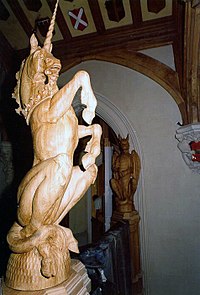
On 20 November 1992, a major fire occurred at Windsor Castle, lasting for fifteen hours and causing widespread damage to the Upper Ward.[171] The Private Chapel in the north-east corner of the State Apartments was being renovated as part of a long term programme of work within the castle, and it is believed that one of the spotlights being used in the work set fire to a curtain by the communion table during the morning.[172] The fire spread quickly and destroyed nine of the principal state rooms, and severely damaged over a hundred more.[172] Fire-fighters applied water to contain the blaze, whilst castle staff attempted to rescue the precious artworks from the castle.[173] Many of the rooms closest to the fire had been emptied as part of the renovation work, and this contributed to the successful evacuation of most of the collection.[172] The fire spread through the roof voids and efforts continued through the night to contain the blaze, at great risk to the 200 fire-fighters involved.[174] It was not until late afternoon that the blaze began to come under control, although the fire continued during the night before being officially declared over the next morning.[175] Along with the fire and smoke damage, one of the unintended effects of the fire-fighting was the considerable water damage to the castle, which in many ways caused more complex restoration problems than the fire.[176]
The decision was taken to largely follow the pre-fire architecture with some changes to reflect modern tastes and cost, but fresh questions emerged over whether the restoration should be undertaken to "authentic" or "equivalent" restoration standards. Modern methods were used at Windsor to reproduce the equivalent pre-fire appearance, partially due to the cost.[177] The restoration programme was not completed until 1997, at a total cost of £37 million.[178]

Outside links
| ("Wikimedia Commons" has material about Windsor Castle) |
- Windsor Castle
- Windsor Castle, The Royal Collection – Visitor Information
References
- ↑ The King's Drawing Room, King's Ballroom, King's Audience Chamber, King's Presence Chamber, King's Guard Chamber, King's Presence Chamber, King's Audience Room, King's Drawing Chamber and King's Dining Chamber residing in May's 17th-century structure; Wyattville transformed the layout of the eastern end of the State Apartments, forming the Grand Reception Room, White Drawing Room, Green Drawing Room, Crimson Drawing Room, the Waterloo Chamber, State Dining Room and Octagonal Dining Room.
- ↑ The rooms completely or largely destroyed in the fire were St George's Hall, the Lantern Lobby, the Octagonal Dining Room, the Private Chapel, and the Great Kitchen.
- ↑ "Larderie" means "meat passage".
- ↑ This resulted in a change to the official distance to the race; the previous length of a marathon had been around 24 miles; since 1908, the distance has been set at 26 miles and 385 yards, the distance between Windsor Castle and the main stadium.
- ↑ 1.0 1.1 Hugh Roberts, Options Report for Windsor Castle, cited Nicolson, p.79.
- ↑ 2.0 2.1 Robinson, p.27.
- ↑ 3.0 3.1 Brindle and Kerr, p 39
- ↑ Robinson, pp.7, 156.
- ↑ Nicolson, pp.3–4.
- ↑ 6.0 6.1 Nicolson, p.123.
- ↑ Nicolson, p.78; Brindle and Kerr, p.61.
- ↑ Robinson, p.156.
- ↑ Robinson, p.142.
- ↑ 10.0 10.1 Mackworth-Young, p.1.
- ↑ Nicolson, p.120.
- ↑ 12.0 12.1 Robinson, p.55.
- ↑ Brindle and Kerr, p.31.
- ↑ Colvin, p.392, cited Brown (1984), p.230.
- ↑ Robinson, p.92
- ↑ Brindle and Kerr, p.61.
- ↑ Nicolson, p.79.
- ↑ Nicolson, pp.79, 172–3.
- ↑ Nicolson, p.70.
- ↑ Ireland, p.93; Nicolson, p.191.
- ↑ Nicolson, p.176.
- ↑ Nicolson, pp.123, 174; Brindle and Kerr, p.28.
- ↑ 23.0 23.1 Nicolson, p.190.
- ↑ Brindle and Kerr, p.28; Nicolson, p.184.
- ↑ 25.0 25.1 Nicolson, pp.197–8.
- ↑ Nicolson, pp.206–7.
- ↑ Watkin, p.345.
- ↑ Nicolson, p.128.
- ↑ Rowse, p.95.
- ↑ Nicolson, p.191.; Brindle and Kerr, p.56.
- ↑ Robinson, p.74.
- ↑ Robinson, p.118.
- ↑ Nicolson, p.212.
- ↑ Nicolson, p.233.
- ↑ Nicolson, p.234.
- ↑ Nicolson, pp.211, 214, 218.
- ↑ Nicolson, p.235.
- ↑ Nicolson, pp.244–6.
- ↑ Nicolson, pp.246, 264.
- ↑ Nicolson, p.146; Brindle and Kerr, p.26.
- ↑ Emery, p.197.
- ↑ Nicolson, pp.166–7.
- ↑ Nicolson, pp.125, 152.
- ↑ 44.0 44.1 Robinson, p.121.
- ↑ Mackworth-Young, p.20.
- ↑ Robinson, pp.18, 28.
- ↑ Mackworth-Young, p.22.
- ↑ Mackworth-Young, p.22; Rowse, p.37.
- ↑ 49.0 49.1 Tatton-Brown, p.26.
- ↑ 50.0 50.1 Robinson p.26
- ↑ Mackworth-Young, p.80
- ↑ Mackworth-Young, p.81.
- ↑ Robinson, pp.14, 121.
- ↑ Robinson, p.30.
- ↑ Mackworth-Young, p.42.
- ↑ Mackworth-Young, p.72.
- ↑ 57.0 57.1 Robinson, p.122.
- ↑ Cantor, p.105.
- ↑ Robinson, pp.55, 122.
- ↑ Brown (1989), p.230; Cantor, p.105.
- ↑ 61.0 61.1 Mackworth-Young, p.6.
- ↑ Emery, p.193; Tatton-Brown, p.18; Robinson, p.11.
- ↑ 63.0 63.1 Emery, p.193.
- ↑ Brindle and Kerr, p.32.
- ↑ Brindle and Kerr, pp.32–3.
- ↑ 66.0 66.1 Brindle and Kerr, p.33.
- ↑ 67.0 67.1 67.2 Tatton-Brown p.24
- ↑ Brindle and Kerr, p.34.
- ↑ 69.0 69.1 69.2 69.3 69.4 Steane, p.110
- ↑ Nicolson, pp.118–9.
- ↑ Nicolson, p.106.
- ↑ Brown (1984), p.91; Nicolson, p.122.
- ↑ Brown (1989), p.230.
- ↑ Ritchie, p.100.
- ↑ Rowse, p.28
- ↑ Rowse, p.29.
- ↑ Rowse, p.31.
- ↑ Rowse, p.39.
- ↑ 79.0 79.1 Rowse, p.43.
- ↑ Brindle and Kerr, p.46; Rowse, p.43.
- ↑ Rowse, p.47.
- ↑ Rowse, p.48.
- ↑ Rowse, pp.52–3.
- ↑ Rowse, p.61.
- ↑ Brindle and Kerr, p.46; Rowse, p.47.
- ↑ 86.0 86.1 86.2 Brindle and Kerr, p.46
- ↑ Mackworth-Young, p.25.
- ↑ 88.0 88.1 Williams (1860), p.69.
- ↑ Rowse, p.57.
- ↑ Williams (1971), p.25.
- ↑ Rowse, p.67.
- ↑ 92.0 92.1 Rowse, p.64.
- ↑ Brindle and Kerr, pp.46–7.
- ↑ Rowse, pp.64, 66.
- ↑ 95.0 95.1 95.2 Brindle and Kerr, p.47.
- ↑ Brindle and Kerr, p.47; Rowse, pp.64–5.
- ↑ Rowse, p.66.
- ↑ Rowse, p.69.
- ↑ Rowse, p.74; MacGregor, p.86.
- ↑ Rowse, p.74.
- ↑ Rowse, p.77.
- ↑ Rowse, pp.56, 79; Hoak, p.98.
- ↑ 103.0 103.1 Rowse, p.79
- ↑ 104.0 104.1 104.2 104.3 104.4 104.5 Rowse, p.80.
- ↑ Mackworth-Young, p.36.
- ↑ 106.0 106.1 Rowse, p.84.
- ↑ Rowse, p.85.
- ↑ Dixon, p.269.
- ↑ Spencer, p.326.
- ↑ Spencer, pp.327–9.
- ↑ Spencer, p.331.
- ↑ 112.0 112.1 Watkin, p.335.
- ↑ Barnard, p.257.
- ↑ 114.0 114.1 Thurley, p.229.
- ↑ Newman, p.81.
- ↑ 116.0 116.1 Robinson, p.55; Mackworth-Young, p.45.
- ↑ Mackworth-Young, p.45.
- ↑ 118.0 118.1 Tite, p.110.
- ↑ Tite, p.24; Robinson, p.57.
- ↑ 120.0 120.1 120.2 Robinson, p.57.
- ↑ Robinson, pp.57–8.
- ↑ Tite, p.110; Robinson, p.60; Bickham; Pote.
- ↑ 123.0 123.1 Robinson, p.59.
- ↑ 124.0 124.1 Robinson, p.58.
- ↑ 125.0 125.1 Robinson, p.76.
- ↑ Robinson, pp.74–5.
- ↑ Robinson, p.81.
- ↑ Robinson, p.75.
- ↑ Robinson, pp.60–2.
- ↑ Clarke and Ridley, p.46.
- ↑ Clarke and Ridley, p.48; Robinson, p.71.
- ↑ 132.0 132.1 132.2 Robinson, p.85.
- ↑ Ireland, p.92; Nicolson, p.79, pp.172–3.
- ↑ Robinson, p.89.
- ↑ Robinson, pp.91, 93.
- ↑ 136.0 136.1 Robinson, p.96.
- ↑ Robinson, p.92; Prince Charles, quoted Nicolson, p.126.
- ↑ Robinson, p.117; Rowse, p.207; Mackworth-Young, p.75.
- ↑ Robinson, pp.117, 126.
- ↑ Rowse, p.207.
- ↑ Rowse, p.209.
- ↑ Rowse, p.221.
- ↑ Robinson, p.129.
- ↑ Mackworth-Young, p.75.
- ↑ Rowse, p.237; Mackworth-Young, p.75.
- ↑ Robinson, pp.118–9.
- ↑ Brindle and Kerr, p.56.
- ↑ Robinson, p.124.
- ↑ Robinson, pp.119–21.
- ↑ 150.0 150.1 Rowse, p.234.
- ↑ Robinson, p.126
- ↑ 152.0 152.1 152.2 Tighe and Davis, p.656.
- ↑ Robinson, pp.122–3.
- ↑ Tighe and Davis, p.655.
- ↑ Robinson, p.135; Hibbert, p.191.
- ↑ Robinson, p.135; Hibbert, pp.191–2.
- ↑ Robinson, p.135; Hibbert, p.192.
- ↑ Senn, p.24; Rowse, p.247.
- ↑ Robinson, p.136.
- ↑ Robinson, pp.136–7; Rowse, p.247.
- ↑ 161.0 161.1 Robinson, p.138.
- ↑ Robinson, p.137.
- ↑ Robinson, pp.139–140.
- ↑ Shawcross, p.487.
- ↑ Robinson, pp.138–9; Shawcross, p.487.
- ↑ 166.0 166.1 Shawcross, p.527.
- ↑ Shawcross, pp.604–5; p.594.
- ↑ 168.0 168.1 Mackworth-Young, p.88.
- ↑ Nicolson, p.4.
- ↑ Emery, p.193; Brindle and Kerr, p.5.
- ↑ Robinson, p.143; Nicolson, p.30.
- ↑ 172.0 172.1 172.2 Robinson, p.144.
- ↑ Nicolson, p.11.
- ↑ Nicolson, pp.23, 25.
- ↑ Nicolson, p.30.
- ↑ Nicolson, p.110.
- ↑ Nicolson, pp.78–9.
- ↑ Nicholson, p.260.
Books
- Barber, Richard. (2007) "The Round Table Feast of 1344," in Munby, Barber and Brown (eds) 2007.
- Barnard, Toby. (2009) "The Viceregal Court in Later Seventeenth-Century Ireland," in Cruickshanks (ed) 2009.
- Bickham, George. (1753) Deliciæ Britannicæ; or, the Curiosities of Kensington, Hampton Court, and Windsor Castle, Delineated. London: Owen. OCLC 181805261.
- Bold, John and Chaney, Edwards. (eds) (1993) English Architecture, Public and Private: essays for Kerry Downes. London: Hambledon Press. ISBN 978-1-85285-095-1.
- Brindle, Steven and Kerr, Brian. (1997) Windsor Revealed: New Light on the History of the Castle. London: English Heritage. ISBN 978-1-85074-688-1.
- Brown, Reginald Allen. (1984) The Architecture of Castles: A Visual Guide. London: Batsford. ISBN 978-0-7134-4089-8.
- Brown, Reginald Allen. (1989) Castles From the Air. Cambridge: Cambridge University Press. ISBN 978-0-521-32932-3.
- Cantor, Leonard Martin. (1987) The Changing English Countryside, 1400–1700. London: Routledge. ISBN 978-0-7102-0501-8.
- Clarke, John and Ridley, Jasper Godwin. (2000) The Houses of Hanover and Saxe-Coburg-Gotha. Berkeley, US: University of California Press. ISBN 978-0-520-22801-6.
- Colvin, Howard Montagu. (ed) (1973) The History of the King's Works, Volume VI, 1782–1851. London: Her Majesty's Stationery Office. OCLC 77106638.
- Cruickshanks, Eveline. (ed) (2009) The Stuart Courts. Stroud, UK: The History Press. ISBN 978-0-7524-5206-7.
- Dixon, William Hepworth. (1880) Royal Windsor, Volume IV. London: Hurst and Blackett. OCLC 455329771.
- Emery, Anthony. (2006) Greater Mediæval Houses of England and Wales, 1300–1500: Southern England. Cambridge: Cambridge University Press. ISBN 978-0-521-58132-5.
- Ireland, Ken. (2006) Cythera Regained?: the Rococo Revival in European Literature and the Arts, 1830–1910. Cranbury, US: Fairleigh Dickinson Press. ISBN 978-0-8386-4078-4.
- Hibbert, Christopher. (2007) Edward VII: The Last Victorian King. New York: Palgrave Macmillan. ISBN 978-1-4039-8377-0.
- Hoak, Dale. (1995) "The Iconography of the Crown Imperial," in Hoak (ed) 1995 Tudor Political Culture. Cambridge: Cambridge University Press. ISBN 978-0-521-52014-0.
- House of Commons Public Accounts Committee. (2009) Maintaining the Occupied Royal Palaces: Twenty-fourth Report of Session 2008–09, Report, Together with Formal Minutes, Oral and Written Evidence. London: The Stationery Office. ISBN 978-0-215-53049-3.
- Knox, Ronald and Leslie, Shane. (eds) (1923) The Miracles of King Henry VI. Cambridge: Cambridge University Press.
- MacGregor, Arthur. (2009) "The Household Out of Doors: the Stuart Court and the Animal Kingdom," in Cruickshanks (ed) 2009.
- Mackworth-Young, Robin. (1992) The History and Treasures of Windsor Castle. Andover, UK: Pitkin. ISBN 978-0-85372-338-7.
- Munby, Julian; Barber, Richard and Brown, Richard. (eds) (2007) Edward III's Round Table at Windsor. Woodbridge, UK: Boydell. ISBN 978-1-84383-391-8.
- Newman, John. (1993) "Hugh May, Clarendon and Cornbury," in Bold and Chaney (eds) 1993.
- Nicolson, Adam. (1997) Restoration: The Rebuilding of Windsor Castle. London: Michael Joseph. ISBN 978-0-7181-4192-9.
- Pounds, Norman John Greville. (1990) The Mediæval Castle in England and Wales: a social and political history. Cambridge: Cambridge University Press. ISBN 978-0-521-45828-3.
- Pote, Joseph. (1755) Les Delices de Windsore: or, a Description of Windsor Castle and the Country Adjacent. Eton: Joseph and Thomas Pote. OCLC 181833487.
- Ritchie, Leitch. (1840) Windsor Castle, and Its Environs. London: Longman. OCLC 38518607.
- Robinson, John Martin. (2010) Windsor Castle: the Official Illustrated History. London: Royal Collection Publications. ISBN 978-1-902163-21-5.
- Rowse, Alfred Leslie. (1974) Windsor Castle in the History of the Nation. London: Book Club Associates. ISBN 978-1-902163-21-5.
- Rubin, Miri. (2006) The Hollow Crown: a History of Britain in the Late Middle Ages. London: Penguin Books. ISBN 978-0-14-014825-1.
- Senn, Alfred Erich. (1999) Power, Politics, and the Olympic Games. Champaigne, US: Human Kinetics. ISBN 978-0-88011-958-0.
- Shawcross, William. (2009) Queen Elizabeth the Queen Mother : the Official Biography. London: Macmillan. ISBN 978-1-4050-4859-0.
- South, Raymond. (1977) The Book of Windsor. Chesham, UK: Barracuda Books. ISBN 978-0-86023-038-0.
- Spencer, Charles. (2007) Prince Rupert: The Last Cavalier. London: Phoenix. ISBN 978-0-297-84610-9
- Steane, John. (1999) The Archaeology of the Mediæval English Monarchy. London: Routledge. ISBN 978-0-415-19788-5.
- Tatton-Brown, Tim. (2007) "Windsor Castle Before 1344," in Munby, Barber and Brown (eds) 2007.
- Thurley, Simon. (2009) "A Country Seat Fit For a King: Charles II, Greenwich and Winchester," in Cruickshanks (ed) 2009.
- Tighe, Robert Richard and Davis, James Edward. (1858) Annals of Windsor, Being a History of the Castle and Town, with some Account of Eton and Places Adjacent, Volume II. London: Longman. OCLC 3813471.
- Tite, Catherine. (2010) Portraiture, Dynasty and Power: Art Patronage in Hanoverian Britain, 1714–1759. Amherst, US: Cambria Press. ISBN 978-1-60497-678-6.
- Watkin, David. (2005) A History of Western Architecture. London: Laurence King. ISBN 978-1-85669-459-9.
- Williams, Robert Folkestone. (1860) Domestic Memoirs of the Royal Family and of the Court of England, Chiefly at Shene and Richmond, Volume 2. London: Hurst and Blackett. OCLC 8987461.
- Williams, Neville. (1971) Royal Homes. Cambridge: Lutterworth Press. ISBN 978-0-7188-0803-7.
- Wolffe, Bertram. (2001) Henry VI. New Haven and London: Yale University Press. ISBN 978-0-300-08926-4.

